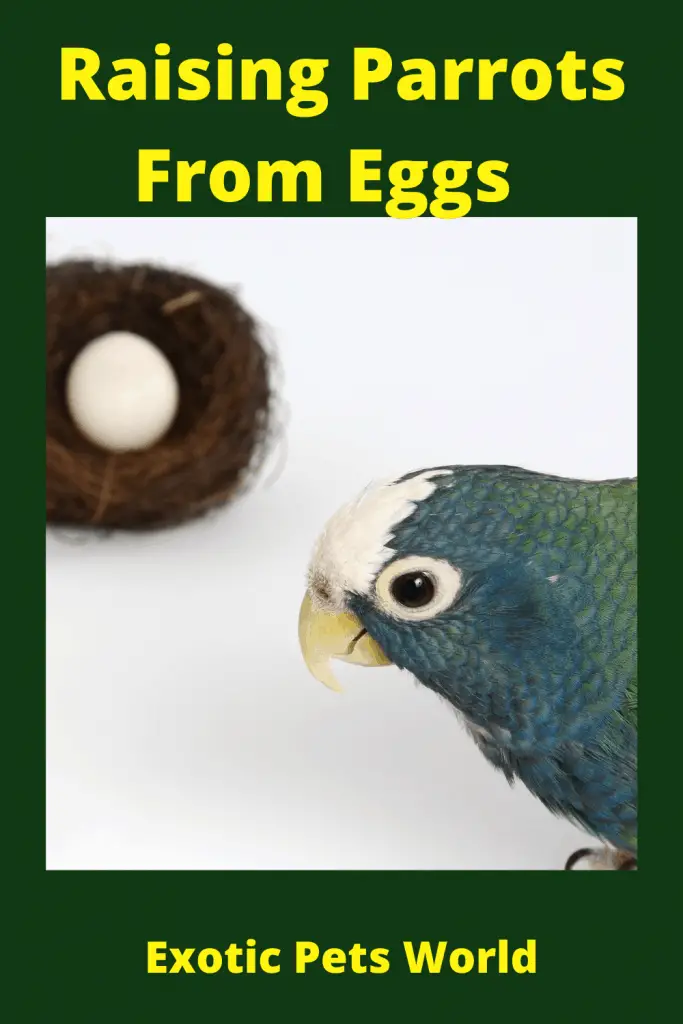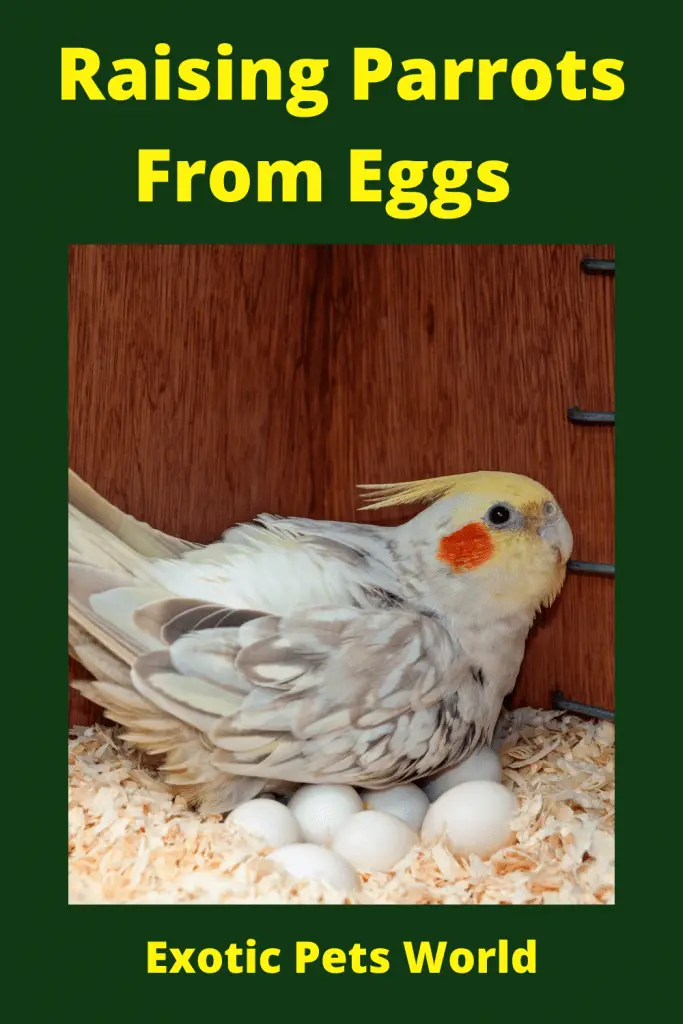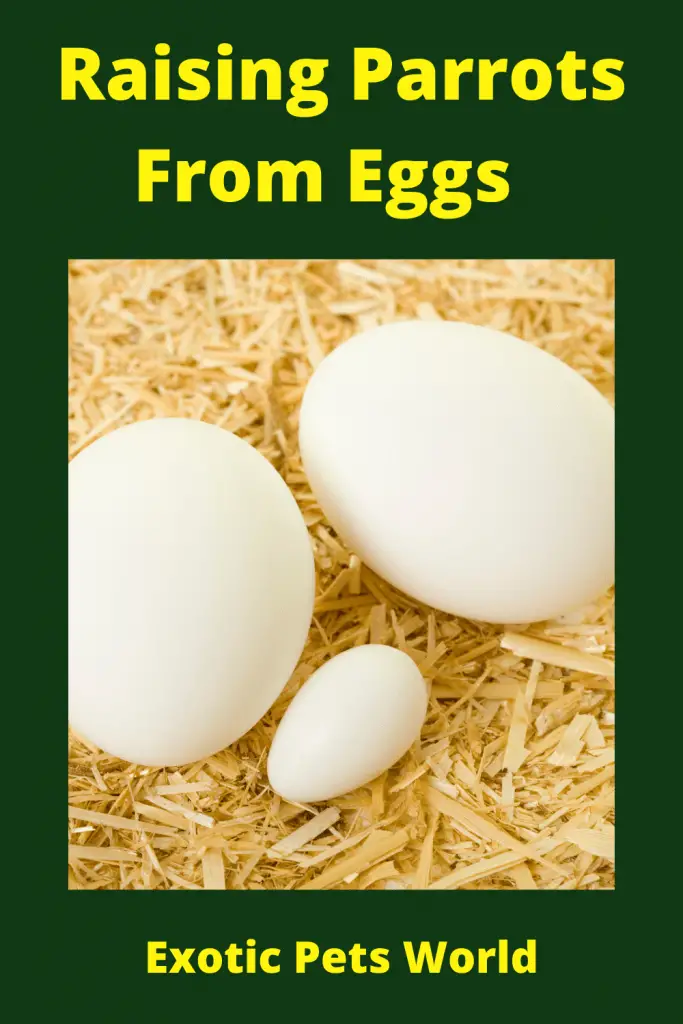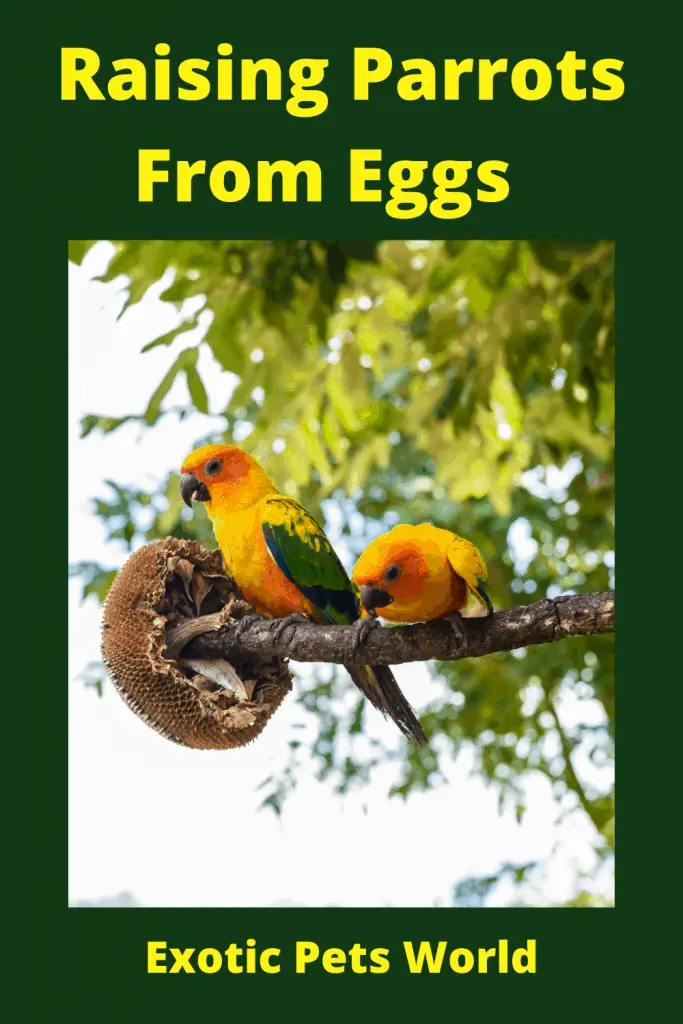Raising Parrots From Eggs. The term ‘pet parrot’ occupies many territories, leaving the size of a tiny goose from sparrow-sized parrot to cockatoos. Species such as the Cockatiel, tough characters like the Macaws, and all points in-between are easy-to-keep.
Your most significant issues for smaller parrots would be that of the general bird keeper – making sure that none of them is bullied, allowing them plenty of room and healthy food, and even hand-taming them to make the whole process of pet-keeping more fun.
However, for any of the more giant birds, you can still interact with an animal whose intellect has been compared to a five-year-old child’s.
It is one of the truly remarkable things about parrots. Some of them will give dolphins and great apes a run for their money when it comes to intellect, along with individual members of the crow tribe.
What this wide variety of sizes and minds suggests is that all households are suited to a parrot. This guide looks at the most common species’ criteria in detail and serves as a guide for all parrot species kept as pets.

Raising Parrots From Eggs / History
Parrot, a term applied to a vast number of raucous, gaudy birds of the Psittacidae family. Parrot is often used to refer to any member of the broader group of birds, the Psittaciformes order, which also includes cockatoos (Cacatuidae family).
Since ancient times, parrots have been kept as cage birds, and they have always been expected as they are humorous, intelligent, and sometimes affectionate. Several, like the human voice, are remarkably imitative of many sounds.
There are 333 species counted in the Psittacidae family. The Psittacinae subfamily, the “true” parrots, is the largest subfamily by far, with members worldwide in warm regions.
These birds eat nuts, buds, and certain fruits and insects and have a sharp tongue. Most subfamily members are commonly referred to as parrots, although more formal names such as macaw, parakeet, conure, and lovebird apply to different subgroups.
Breed Characteristics
A robust, curved bill, an erect posture, strong legs, and clawed zygodactyl feet are typical characteristics of parrots. Many parrots are colored brightly, while others are multi-colored.
The perceptual spectrum in most parrots shows little to no sexual dimorphism. In terms of range, they type the bird order with the most variable scale. Seeds, seeds, berries, buds, and other plant materials are the essential components of most parrot diets.
Parrot Food
Fruit, berries, nuts, beans, some extra protein in cooked meat shape, and a specially prepared parrot mix base. That’s the basis of the diets of most pet parrots. However, no one diet suits all parrot types. It’s also not just a matter of distance. Hyacinth Macaws are insane for seeds, and individual animals live on a somewhat carnivorous diet. Lories and Lorikeets feed on nectar in the wild.
If you want to give the bird the best chance of a long, stable life, finding out every last detail about the nutritional needs of your particular parrot is crucial. Some of them may be fussy or addicted to those foods. All birds must consume the full variety of fresh, dry, and formulated diets that cover all their nutritional needs.
Based on the needs of two of the most common parrot types, the Cockatiel and the African Grey, the parts that follow address the general parrot diet. On the mentioned diet, several other organisms can survive – however, again, you must consult with your supplier for precise advice.

Parrot Breeding
With some hundred separate parrot species usually owned as pets. – species has its specific criteria, and for the typical birds you are attempting to breed, expert advice should be pursued.
Generally speaking, aside from other pairs or a non-breeding flock, breeding birds must be housed. Parents are very territorial, and disputes that endanger life are possible. It is not going to be a concern if you keep a couple of parrots.
How Much Space Does a Breeding Pair of Parrots Need?
The aviary room would have to be at least ( 12′ x 3′ ), 360cm in length, 90 centimeters wide, and 180centimetres high for moderate parrot pairs. There has to be an indoor room inside this, at least(4′ x 3′ ) 120 long and 90 cm tall, containing a nesting area.
Lifting the whole protected portion off the ground and lining the wire mesh base makes it easier to clean a breeding aviary since many feces would drop to the floor.
Flock birds would deal with limited breeding areas better than more territorial birds, such as Cockatiels, Budgies, and Lovebirds. To encourage male and female birds to have their personal space, less gregarious species would require a lot more space.
Parrot Breeding Problems
When you’re trying to breed parrots, several things can go wrong:
- Calcium deficiency will contribute to egg binding, so make sure there is plenty of calcium in women’s diets. A depressed male may assault the nesting hen; thus, monitor the pair to ensure they’re happily sharing a home. Many things can influence the male to snap, typically problems due to limited space or the existence of disruptive and regional neighbors and friends.
- To such a degree, feeding birds’ added burden means killing them; territorial males will expend all their energies on aggression.
- The cause of tension and aggression may be a mating couple of the same – or strongly linked – species.
- Over the next cage, an irritated male, having trouble getting his beak or claws on the competitor, can also take out his frustration on roosting the female, the eggs, or even the chicks. Testing the aviary’s cage section with a definite separation will help resolve conflicts with a logic of ‘out of sight or out of mind.’
- The birds will not breed if it is too cold. It would help if you heated the nesting areas to the temperature recommended for your unique parrot species.
- Those pairs are just not going to hit it off. You would have to add a new prospective partner to the female in this case (first eliminating the unsuccessful/disinterested male). Note: the group will pair off without your interference if you hold the flocking bird-like, such a cockatiel, and budgerigar; that is one reason why flock birds are widespread.
- Elderly birds are far less likely to partner up but also heed nature’s call. Baby birds are far more likely to reproduce, or in their first year, someone fresh to parrot reproduction can start with useful tests. (To guarantee new, fertile birds of the right sex, a reliable breeder is an absolute must here!)

Nest Boxes
Each species of parrot has specifications for its form of the nestbox.
Therefore, the following advice is generic, and you should still pursue advice about your unique type of parrot. It is usually advised to have a deep package, something appropriately dark to make parents and chicks feel secure and safe. An inverted L-shaped box is a common alternative, allowing the parrot convenient access from the box entrance to a nesting ‘shaft’ that is not apparent.
In an L-shaped box, the nesting area would require some ladder to allow the bird clear access from the entrance to the bottom of the box. The right choice is wooden slats or dowelling that is firmly nailed to the side. Gnawing wood in Parrots activates the breeding instinct, so a supply in the cage is a successful ploy. As part of the nest, the pulp will then be used by the birds.
Nest boxes require a side inspection door, somewhere at the top of the nest. A peephole at the top of the box is a terrible idea since the nesting bird would be frightened. If the birds are aggressive or over-nervous, fight the temptation to spy on them continuously. Parrots tend to cram into their nests, and anything too large would not be as welcoming or inviting. The entry to the nest box should be short.
Parrot Eggs ( 2-6)
Depending on the type, the eggs can take between 2.5 and 4 weeks to hatch. Generally speaking, the bigger the bird, the more prolonged the incubation. The size of the clutches ranges from two to six, with the female laying one a day. Egg-hatching incubators are not a necessary kit for a breeder, but they are used by many.
A temperature of ( 98.6 F), 37C or just below is needed for the eggs of all parrots. For good hatching, having this right is essential. Eggs struggle to hatch occasionally. There are different explanations for why this could have occurred:
- When there are no males to fertilize them, females often lay eggs.
- If the male has failed to achieve a good pairing, a female can lay unfertilized eggs
- Due to a chick not forming correctly inside, or because the egg itself somehow managed to avoid being fertilized, single eggs may fail to hatch.
- Due to inexperience or stress, the hen can neglect its eggs – this is very normal in first-time layers.
- The egg might have dropped to the floor and destroyed the embryo inside if the nest box is not the right size and form.
- The male bird may have been infertile,
- The concern may be the closeness of other birds or external distractions – the female may be too stressed to sit on her eggs.
- Nutrition is vital – if eggs fail to hatch due to soft shells, it is an indication that when she created the eggs, the hen did not get enough calcium (for example, from cuttlefish bone or a mineral block).
Looking After Parrot Chicks
When weaned, before being exposed to other adult birds, the chicks would require a dedicated ‘nursery’ area of the aviary.
With a leg ring of the right size for your bird type, new birds should be ringed. It is a structured item that may include the bird’s details, breeder, and birth time. Some breeders, too, fit their custom plastic rings.
Talk to a breeder for instructions on this and never try to ring a bird without knowing from a specialist how to do so.
Baby parrots require a stock of soft seeds before and after weaning. The chick is likely to die if a parent loads their chick’s crop with dried seed.
Since their ‘freedom,’ the soft foods should be opened to weaned birds for several weeks. It takes time for their digestive tracts to become strong enough to deal with pellets and dry fruits, and as long as the soft food is there for them, they can adequately forage at a feeding station.

In several parrot species, when she is seated, the male feeds the hen with a regurgitated seed porridge, and she will provide the chicks before they leave the nest. The cock can then engage in the chick-feeding, but the female does all the weaning in many species.
Once all of the chicks have hatched, droppings will soon collect. The nest box has to be washed out at least once a week. Remove as much of the soiled material as you can, but as you try to scrub their nest, do not shove the chicks around too much. For hand-rearing parrots, since each species has varying criteria, you will need to seek expert advice.
You will also read that by the time they escape, if you start taming the chicks at two weeks old, they will be reasonably hand tamed. It would make it easier to teach them later, intuition suggests; but the argument is always driven too hard.
Even if they have never been hand-fed, parrots can be tamed and conditioned, so don’t believe this is something you have to do. In fact, given the dangers of novice and feeding of very young birds (including crops affected, seed burns, and mouth injuries), if possible, it is something you can prevent.
Choosing a Cage ( Mesh Spacing)
It would help if you ensured that the bar spacing is reasonable for the parrot size you choose to hold while picking a cage. Cockatiels and any species smaller than that need a bar spacing of ( 1/3″ ) 1 cm inch; larger ones need up to ( 1/2″), 1.5-2 cm, and enclosures with a spacing of (3/4″), 2.5 cm can be provided to large parrots. The theory has little to do with climbing challenges and more about parrots having their heads caught.
It can if the bird can wedge its head between the bars. Many parrots like to ascend, but for them, horizontal bars are a must. Being smart and curious birds, parrots will get bored fast. The cage needs to have plenty of range from various forms of perch and climbing apparatus to a rota of ever-changing toys. The more room you’re able to make, the better.
Parrot Diseases
In general, parrots are sturdy birds who live long and happy lives. Nonetheless, different illnesses, such as the common cold, will deteriorate temporarily but quickly gone. Its trick would be to get proper treatment as soon as possible and follow the vet’s advice.
Aspergillus
It is an infection of fungus in parrots’ air sacs or lungs, generally contracted in moist and unclean conditions in which the fungus may grow. Breathing problems are the signs, including loud wheezing, followed by scooped feathers or a ‘bad’ look in general. Discharge from the nostrils is also present.
Avian Gastric Yeast
This incredibly infectious disease, triggered by a yeast infection or secondary bacterial infection, is also recognized as macrorhabdiosis. It mainly affects budgets.
It’s also hard to spot in the initial stages, breeding with no visible warning sign. Its first external alarm since AGY impedes digestion is weight loss. In the droppings, undigested food can be contained, or birds could spit food or phlegm.
Candidiasis
It is a plague of yeast, the same one that infects people. These flowers with bird’s crop or digestive system cannot be transmitted to humans by bird species except if you enable them to kiss you.
There might be lethargic birds that are infected and may have loose droppings. While there are many types of ailment symptoms, it is necessary to make a diagnostic trip to the vet. Treating Candida is easy.
Sneezes and Colds
Parrots can get colds, or the health conditions – rubbery nose or swollen eyes, coughing, and sniffling – are similar. However, the viruses are separate from those that infect humans. However, in parrots, the disease would lead to rapid decay, and administration by a veterinarian will be appropriate.
Proventricular Dilatation Syndrome
There will be an increased hunger for infected birds, but they will lose weight and move food particles into their feces. It is an infectious illness that affects problems with digestion. Vomiting, too, will occur.
There may be a considerable decrease in well-being, resulting in mortality if it is not allowed to treat. It is not exclusive in the macaws. However, it is not possible to transmit it to people. The best option is to resist routine and extensive cage washing since an infected bird is unlikely to survive, and a vet usually advises euthanasia.

Nutritional Deficiencies
There are numerous signs of an inadequate diet, from feather loss to malformation of the beak to personality issues and a quick descent to death. Both pet birds require vitamins and minerals and protein, fatty acids, and various micronutrients in their prescribed daily doses. A healthy diet and access should supply all these needs to a mineral block.
Can My Parrot Get Mites?
Birds can get external parasites, like many other species of animals. When the parrots are discovered to have mites, they need to be handled immediately. It can not only make the parrots ill, but it can propagate multiple mites to humans. Bird mites feed on the blood of the parrots and will live in cages or nests as well.
Can My Parrot Get Fleas?
Parrots wouldn’t usually get fleas, and if they’re allowed outside on the floor or the field where the little vampires are known to hang out, they can. Neither situation is possible because you’ll never dream of allowing your bird on the floor or dirt where threats other than parasites lurk, like a real parrot parent.
Conclusion
To determine the best times for your parrots to successfully reproduce, we shall investigate their standard breeding times in the wild compared to the climatic zones they occupy. Establish a breeding plan to ensure your birds are breeding at the most suitable time of year, based on this knowledge and from your observations of the flock. It will improve the odds and effects of breeding and foster a large and stable flock during the year.
During their average molding period, parrot breeding pairs should not be permitted to reproduce. The nest boxes should be withdrawn or covered over at this period not to stimulate the birds’ breeding cycle.
The pairs should obtain a nutritional molt program to accelerate the development of new feathers and enable the molt to be completed in the shortest possible time. During the mold, this improved nutrient level primes parrots into breeding condition. The food regimen then proceeds into the breeding season smoothly, resulting in high fertility and strong, stable offspring. Breeding requires a great deal of time, effort, money, and skills.

Thank you for the auspicious writeup. It in fact was once a enjoyment account it. Glance complex to more added agreeable from you! By the way, how could we be in contact?
Do you mind if I quote a couple of your posts as long as I provide credit and sources back to your webpage? My blog is in the very same area of interest as yours and my users would truly benefit from a lot of the information you provide here. Please let me know if this ok with you. Regards!
Hi, i think that i saw you visited my site so i came to 搑eturn the favor?I’m trying to find things to improve my website!I suppose its ok to use some of your ideas!!
Nearly all of whatever you say is astonishingly precise and that makes me wonder the reason why I hadn’t looked at this with this light previously. This article truly did turn the light on for me as far as this particular subject matter goes. But there is 1 issue I am not really too comfortable with and whilst I attempt to reconcile that with the core theme of the position, let me observe exactly what all the rest of your subscribers have to say.Very well done.
You should participate in a contest for the most effective blogs on the web. I’ll suggest this web site!
It’s a pity you don’t have a donate button! I’d definitely donate to this excellent blog! I guess for now i’ll settle for bookmarking and adding your RSS feed to my Google account. I look forward to new updates and will share this blog with my Facebook group. Talk soon!
Terrific post however I was wanting to know if you could write a litte more on this subject? I’d be very grateful if you could elaborate a little bit more. Appreciate it!
Whoa! This blog looks exactly like my old one! It’s on a totally different topic but it has pretty much the same layout and design. Superb choice of colors!
you are really a good webmaster. The site loading speed is amazing. It seems that you’re doing any unique trick. Also, The contents are masterpiece. you have done a great job on this topic!
Greetings! I’ve been following your website for a long time now and finally got the bravery to go ahead and give you a shout out from Porter Tx! Just wanted to mention keep up the great job!
I gotta favorite this internet site it seems very helpful very helpful
I’m really enjoying the design and layout of your site. It’s a very easy on the eyes which makes it much more enjoyable for me to come here and visit more often. Did you hire out a designer to create your theme? Superb work!
We absolutely love your blog and find a lot of your post’s to be precisely what I’m looking for. can you offer guest writers to write content available for you? I wouldn’t mind publishing a post or elaborating on some of the subjects you write regarding here. Again, awesome web site!
DreamProxies.com – 100 your best private proxies along with significant special discounts + Excellent quick proxy serrvers!
BEST PRIVATE PROXIES – Top-notch good quality, Endless data transfer, 1000 mb/s superspeed, 99,9 uptime, Un consecutive IP’s, Certainly no ingestion standards, An array of subnets, USA or possibly The european countries proxies – Get Now – https://DreamProxies.com
Elite Private proxy store https://DreamProxies.com – the best private proxies you can find for cheapest rates!
Cheapest private proxies – prices only $0.15 every proxies! Buy at this moment and have 50 discount for ones proxies package – DreamProxies.com
Very well written story. It will be helpful to everyone who usess it, including myself. Keep up the good work – looking forward to more posts.